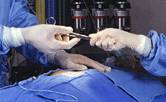
MONDAY, Jan. 18 (HealthDay News) — In some cases of ruptured abdominal aortic aneurysm, minimally invasive repair could be more effective at saving lives than traditional open surgery.
Abdominal aortic aneurysm (AAA) is a bulging of the aorta, the largest blood vessel in the body. If the aneurysm ruptures, it causes rapid blood loss and a high risk of death. Each year, 13,000 Americans die from ruptured AAA.
If detected before it ruptures, an AAA that’s two inches or larger can be repaired surgically or with minimally invasive endovascular aneurysm repair (EVAR). In an emergency, patients usually undergo open surgical repair, which involves general anesthesia, an abdominal incision up to 12 inches long, clamping of the aorta and replacing the enlarged section of the aorta with a fabric graft.
In EVAR, doctors use X-ray guidance to thread a catheter through an incision in the groin to the AAA. They advance a collapsed stentgraft, called an endograft, through the catheter, which, once in place, is expanded inside the aneurysm. The aorta’s blood flow is redirected through the endograft.
The report is scheduled to be presented Jan. 18 at the annual International Symposium on Endovascular Therapy in Hollywood, Fla.
More information
The Society for Vascular Surgery has more about abdominal aortic aneurysm.

